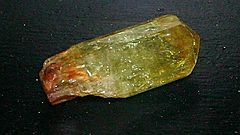Apatite facts for kids
Quick facts for kids Apatite group |
|
|---|---|
 |
|
| General | |
| Category | Phosphate mineral |
| Formula (repeating unit) |
Ca5(PO4)3(F,Cl,OH) |
| Strunz classification | 08.BN.05 |
| Identification | |
| Color | Transparent to translucent, usually green, less often colorless, yellow, blue to violet, pink, brown. |
| Crystal habit | Tabular, prismatic crystals, massive, compact or granular |
| Crystal system | Hexagonal dipyramidal (6/m) |
| Cleavage | [0001] indistinct, [1010] indistinct |
| Fracture | Conchoidal to uneven |
| Mohs scale hardness | 5 (defining mineral) |
| Luster | Vitreous to subresinous |
| Streak | White |
| Diaphaneity | Transparent to translucent |
| Specific gravity | 3.16–3.22 |
| Polish luster | Vitreous |
| Optical properties | Double refractive, uniaxial negative |
| Refractive index | 1.634–1.638 (+0.012, −0.006) |
| Birefringence | 0.002–0.008 |
| Pleochroism | Blue stones – strong, blue and yellow to colorless. Other colors are weak to very weak. |
| Dispersion | 0.013 |
| Ultraviolet fluorescence | Yellow stones – purplish-pink, which is stronger in long wave; blue stones – blue to light-blue in both long and short wave; green stones – greenish-yellow, which is stronger in long wave; violet stones – greenish-yellow in long wave, light-purple in short wave. |
Apatite is a group of common minerals. These minerals are made of phosphates. They often contain other elements like fluorine, chlorine, or hydroxide. Apatite is special because it's one of the few minerals that living things create and use.
Apatite is not very hard. It has a hardness of 5 on the Mohs scale. This means it can be scratched by harder minerals.
What is Apatite?
The word "apatite" comes from a Greek word. It means "to deceive." This is because apatite can look like other minerals. It comes in many colors, like green, yellow, blue, violet, pink, and brown. It can also be colorless.
Apatite forms in different shapes. It can be found as crystals that look like tables or prisms. It can also be found in large, solid chunks.
Apatite in Your Body
Apatite is super important for living creatures. For example, it makes up a big part of your tooth enamel. This is the hard outer layer of your teeth. It's also a main part of your bones. This form of apatite is called hydroxyapatite. It helps make your bones and teeth strong.
Most of the bone material in your body is a special kind of apatite. In this form, some parts are missing. Instead, it has other elements like carbonate. This makes your bones strong and flexible.
Apatite and Healthy Teeth
Another type of apatite is called fluorapatite. This type is stronger against acid attacks than hydroxyapatite. This is important for your teeth.
In the middle of the 1900s, scientists found something interesting. People who lived in places with natural fluorine in their water had fewer cavities. This is because fluoride ions from the water can replace parts of the apatite in your teeth. This makes your tooth enamel stronger.
This is why many toothpastes today include fluoride. The fluoride helps protect your teeth from decay. It works by making the apatite in your teeth more resistant to acids.
Images for kids
-
Apatite seen under a microscope from the Siilinjärvi apatite mine. The left image uses special light, and the right image uses normal light.
-
An apatite mine in Siilinjärvi, Finland.
See also
 In Spanish: Apatita para niños
In Spanish: Apatita para niños



